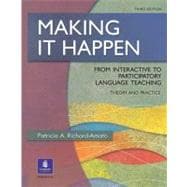This exciting new edition of a classic, best-selling text lays a solid foundation for creating meaningful interaction in the language classroom. A new focus on participatory teaching draws on cutting-edge critical pedagogy to support an already comprehensive research base ¿ and the writing is even friendlier and more accessible than ever!
The Third Edition of Making It Happen features:
- A cyclic approach to theory and practice, reflecting the understanding that theory and practice constantly inform each other.
- Three additions to the extensive Programs in Action section:
-- California's Valley Center Spanish/English Program
-- A Chinese/English program in lower Manhattan
-- Minnesota's Concordia College Village Immersion Model - Case studies for reflection and discussion ranging from elementary through adult.
- Related readings by Vygotsky, Nieto and Pennycook, representing seminal thinking in language teaching.
- The importance of meeting standards and of reflective teaching, so teachers understand the value of examining their own beliefs and practices.
"Making It Happen is a complete text with a great balance between theory and practice, and a wonderful and useful presentation of all the issues a teacher in training needs to be aware of. I would recommend its use for any training course as its sole text...I find it very complete."
-- Alejandra Parra
Nova Southeastern University








